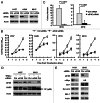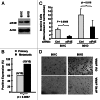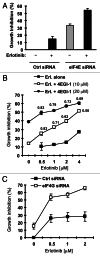Elevated expression of eukaryotic translation initiation factor 4E is associated with proliferation, invasion and acquired resistance to erlotinib in lung cancer
- PMID: 22236867
- PMCID: PMC3679095
- DOI: 10.4161/cbt.18923
Elevated expression of eukaryotic translation initiation factor 4E is associated with proliferation, invasion and acquired resistance to erlotinib in lung cancer
Abstract
Eukaryotic translation initiation factor 4E (eIF4E) is the rate-limiting factor for cap-dependent translation initiation, which is known to regulate oncogenesis. Elevated eIF4E and its negative impact on prognosis in human non-small cell lung cancer (NSCLC) have been reported previously. However, its potential as a therapeutic target and role in regulation of sensitivity to EGFR inhibitors is an area of ongoing investigations. In this study, we detected increased levels of eIF4E in 16 human NSCLC cell lines compared with their normal bronchial epithelial cells. Consistently, human tissue array analysis showed that eIF4E expression was significantly higher in human NSCLC tissues than normal tissues. Inhibition of eIF4E using eIF4E siRNA inhibited the growth and invasion of NSCLC cells. These data suggest that eIF4E overexpression plays a crucial role in positive regulation of the growth and invasion of NSCLC cells. By proteomics, we found that eIF4E levels were elevated in erlotinib-resistant cell lines compared with the sensitive parental cell line. In agreement, assembly of the eIF4F cap complex and several oncogenic proteins regulated by the cap-dependent translation mechanism, were also increased in erlotinib-resistant cells. Thus, erlotinib-resistant cells exhibit elevated eIF4E expression and cap-dependent translation. Inhibition of eIF4F with different means (e.g., gene knockdown) downregulated c-Met expression and partially restored cell sensitivity to erlotinib, suggesting that elevated eIF4E contributes to development of erlotinib resistance, likely through positive regulation of c-Met expression. Taken together, we suggest that elevated eIF4E in NSCLC cells is associated with proliferation, invasion and acquired erlotinib resistance.
Figures







Similar articles
-
Resistance to EGFR-TKI can be mediated through multiple signaling pathways converging upon cap-dependent translation in EGFR-wild type NSCLC.J Thorac Oncol. 2013 Sep;8(9):1142-7. doi: 10.1097/JTO.0b013e31829ce963. J Thorac Oncol. 2013. PMID: 23883783 Free PMC article.
-
Pim-1 kinase is a target of miR-486-5p and eukaryotic translation initiation factor 4E, and plays a critical role in lung cancer.Mol Cancer. 2014 Oct 24;13:240. doi: 10.1186/1476-4598-13-240. Mol Cancer. 2014. PMID: 25342548 Free PMC article.
-
Erlotinib-induced autophagy in epidermal growth factor receptor mutated non-small cell lung cancer.Lung Cancer. 2013 Sep;81(3):354-361. doi: 10.1016/j.lungcan.2013.05.012. Epub 2013 Jun 13. Lung Cancer. 2013. PMID: 23769318
-
Acquired resistance of non-small cell lung cancer to epidermal growth factor receptor tyrosine kinase inhibitors.Respir Investig. 2014 Mar;52(2):82-91. doi: 10.1016/j.resinv.2013.07.007. Epub 2013 Aug 30. Respir Investig. 2014. PMID: 24636263 Review.
-
Targeting mTOR and eIF4E: a feasible scenario in ovarian cancer therapy.Cancer Drug Resist. 2021 May 11;4(3):596-606. doi: 10.20517/cdr.2021.20. eCollection 2021. Cancer Drug Resist. 2021. PMID: 35582305 Free PMC article. Review.
Cited by
-
Eukaryotic translation initiation factor 3 subunit C is associated with acquired resistance to erlotinib in non-small cell lung cancer.Oncotarget. 2018 Dec 25;9(101):37520-37533. doi: 10.18632/oncotarget.26494. eCollection 2018 Dec 25. Oncotarget. 2018. PMID: 30680067 Free PMC article.
-
TRIM59 is a novel potential prognostic biomarker in patients with non-small cell lung cancer: A research based on bioinformatics analysis.Oncol Lett. 2017 Aug;14(2):2153-2164. doi: 10.3892/ol.2017.6467. Epub 2017 Jun 22. Oncol Lett. 2017. PMID: 28789440 Free PMC article.
-
The role of translation initiation regulation in haematopoiesis.Comp Funct Genomics. 2012;2012:576540. doi: 10.1155/2012/576540. Epub 2012 May 9. Comp Funct Genomics. 2012. PMID: 22649283 Free PMC article.
-
miR-34c-3p functions as a tumour suppressor by inhibiting eIF4E expression in non-small cell lung cancer.Cell Prolif. 2015 Oct;48(5):582-92. doi: 10.1111/cpr.12201. Epub 2015 Aug 6. Cell Prolif. 2015. PMID: 26250586 Free PMC article.
-
Impact of the secretome of activated pancreatic stellate cells on growth and differentiation of pancreatic tumour cells.Sci Rep. 2019 Mar 28;9(1):5303. doi: 10.1038/s41598-019-41740-x. Sci Rep. 2019. PMID: 30923340 Free PMC article.
References
Publication types
MeSH terms
Substances
Grants and funding
LinkOut - more resources
Full Text Sources
Other Literature Sources
Medical
Research Materials
Miscellaneous
